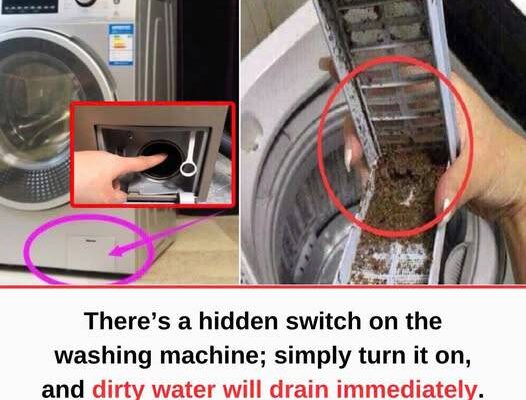In today’s fast-paced world, washing machines have become an indispensable part of modern households. They save us valuable time and effort by taking care of one of the most time-consuming household chores: washing clothes. With just a few button presses, our clothes come out clean and fresh, allowing us to focus on other responsibilities.
However, despite the convenience that washing machines offer, they require regular maintenance to ensure they remain efficient and effective. What many people don’t realize is that there’s a hidden switch on most washing machines that plays a crucial role in their maintenance. This hidden feature allows you to drain dirty water and prevent unpleasant odors, bacteria buildup, and performance issues.
No matter how expensive or technologically advanced your washing machine is, it will eventually accumulate dirt, lint, and bacteria if it’s not cleaned regularly. This buildup can cause your clothes to come out smelling bad or still looking dirty after a wash. Over time, residue from detergents, fabric softeners, and the dirt from your clothes settle in hidden parts of the machine, leading to poor washing results. Experts recommend cleaning your washing machine at least three times a month to maintain its efficiency and prevent potential health risks caused by mold and bacteria growth.
While most users are aware of the self-cleaning cycle available in newer washing machines, many are unaware of the hidden drainage switch located in their appliances. This small but essential feature is usually found in the lower right or left corner of the washing machine, concealed behind a small panel or cover. It’s not always clearly labeled, which is why many people overlook it entirely. To access this switch, you’ll need a coin or a flathead screwdriver to gently pry open the cover.
Once the cover is removed, you’ll typically see a drainage hose or a small knob. Activating this switch or opening the hose will allow stagnant, dirty water trapped inside the machine to flow out. This water often contains detergent residue, lint, and bacteria, all of which can create foul odors and impact the machine’s overall performance. Draining this water regularly is a crucial step in maintaining your washing machine, as it helps prevent clogs, mold growth, and bacterial contamination.
In addition to draining dirty water, it’s equally important to pay attention to the rectangular filter box located inside the washing drum or near the drainage area. This filter is designed to catch lint, stray threads, hair, and other debris during the washing process. Over time, the filter can become clogged, restricting water flow and reducing the efficiency of the wash cycle. If this filter isn’t cleaned regularly, it can lead to detergent buildup, increased energy consumption, and poor washing results.
Cleaning the filter box is a straightforward task that requires just a few minutes of your time. Simply locate the filter, carefully remove it from its housing, and rinse it thoroughly under running water. For stubborn lint or residue, you can use a soft brush to scrub away any buildup. Once clean, dry the filter completely and place it back in its original position. It’s recommended to clean this filter at least once a week, especially if you frequently wash items that shed a lot of lint, such as towels, sweaters, or pet bedding.
It’s worth noting that while many modern washing machines come with a self-cleaning cycle, this feature is not a substitute for manual maintenance. Self-cleaning cycles primarily target the drum and internal pipes, but they don’t address stagnant water trapped in hidden compartments or debris caught in the filter. Combining both manual cleaning and self-cleaning cycles will ensure your washing machine remains in optimal condition.
Regular maintenance of your washing machine not only guarantees cleaner clothes but also extends the lifespan of the appliance. A well-maintained machine consumes less electricity, operates more quietly, and minimizes the risk of costly repairs caused by clogs or mechanical failures.
In conclusion, maintaining your washing machine isn’t a complicated task, but it does require attention to detail. The hidden drainage switch and the rectangular filter box are two often-overlooked components that play essential roles in keeping your washing machine clean and functional. By taking the time to regularly drain dirty water and clean the filter, you can prevent odors, improve washing efficiency, and save yourself from expensive repairs down the line. So, the next time you use your washing machine, take a moment to locate that hidden switch and check the filter. These small maintenance tasks can make a big difference in the performance and longevity of your washing machine, ensuring your clothes come out clean, fresh, and odor-free every time.



